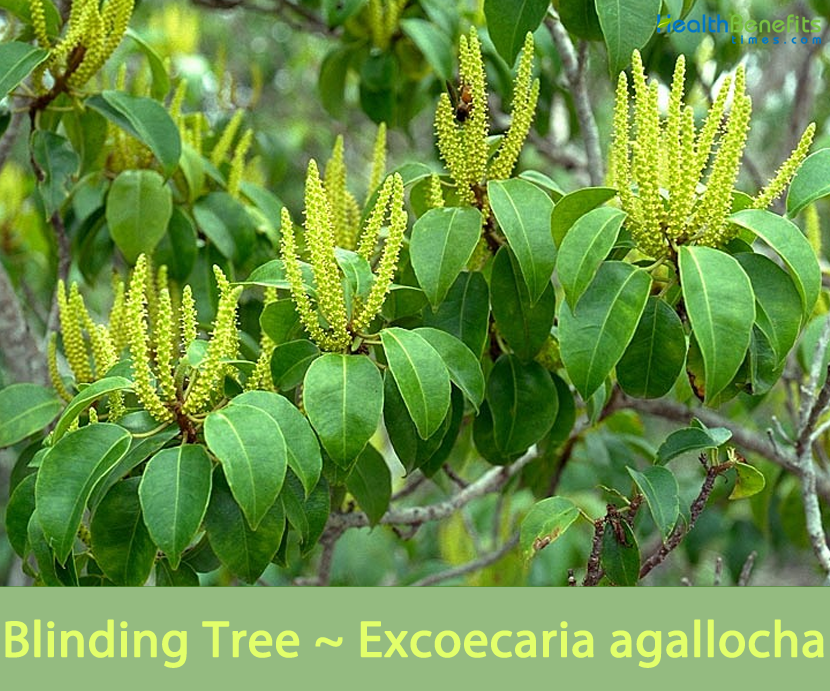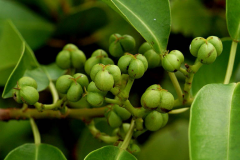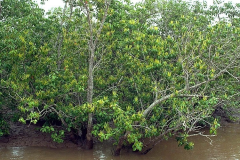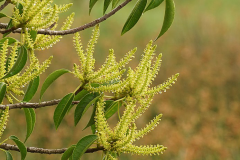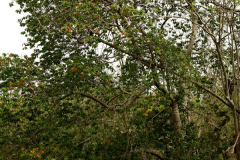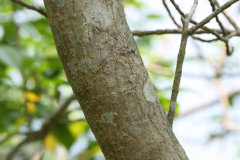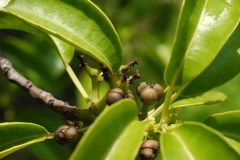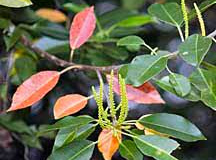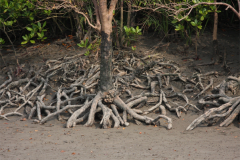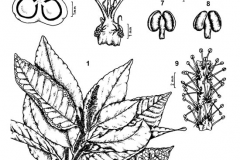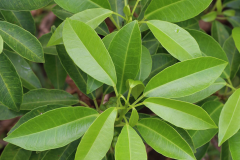Most of the names refer to its toxic properties or its propensity to cause blindness when its latex comes into contact with the eyes. The plant is well-protected by chemical defenses; these include diterpenoids, triterpenoids and flavonoids. The milky latex of Excoecaria agallocha is very poisonous and powerfully irritant, which is not unusual in milky species of plant in the family Euphorbiaceae. Contact with skin causes irritation and rapid blistering; slight contact with eyes can cause temporary blindness, hence the common names that refer to blindness. Even the generic name is from the Latin for “blinder”.
Blinding Tree Facts
| Blinding Tree Quick Facts | |
|---|---|
| Name: | Blinding Tree |
| Scientific Name: | Excoecaria agallocha |
| Origin | Along the coasts of southern India and Sri Lanka, to southern China, Taiwan, Burma (Myanmar), Indo-China, southern Japan, south throughout Southeast Asia |
| Colors | Initially green turning to black as they ripen |
| Shapes | Small smooth capsular fruits that are almost round, 3-lobed, 4.5–5 mm long and 8–9 mm wide |
| Health benefits | Support for epilepsy, obstinate ulcers, leprosy, rheumatism, paralysis, pneumonia, asthma, constipation, arthritis, diabetes, conjunctivitis, dermatitis, and hematuria |
| Name | Blinding Tree |
|---|---|
| Scientific Name | Excoecaria agallocha |
| Native | Along the coasts of southern India and Sri Lanka, to southern China, Taiwan, Burma (Myanmar), Indo-China, southern Japan, south throughout Southeast Asia, to Papua New Guinea, Northern Australia and Pacific Islands |
| Common Names | Blind-your-eye mangrove, blinding tree, buta buta tree, milky mangrove, poison fish tree, and river poison tree, Blind-Your-Eyes, Buta-Buta, Bebuta, Kayu Buta-buta, Kampetti, Thilla, Tilai, Geva, Gewa, Komatti, scrub poison tree, blind-your-eyes-tree, cametty eagle wood, salt swamp tiger’s milk |
| Name in Other Languages | Bengali: Gewa, geoya (গেওয়া) Burma: Kayaw taway Chinese: Hai qi (海漆), Tǔ chénxiāng (土沉香) English: Blind-your-eye, Blind-your-eye mangrove, Blind-your-eyes-tree, Blindingtree, Milky mangrove, River poisontree, Scrub poison tree, buta-buta, geor, gewa, cametty eagle wood, milky mangrove, river poison tree, salt swamp tiger’s milk French: Arbre aveuglant , géor German: Geor-Baum, Gewa-Baum Gujarati: Geva (ગેવા), hura (હુરા) Hindi: Gangiva, Tejbala, Thillai Indonesia: Kayu buta-buta, Kayu betah, Menengan Italian: Geor Japanese: Shimashiraki (シマシラキ), Okinawajinkou (オキナワジンコウ) Javanese: Buta-buta Kannada: Harogida (ಹಾರೋಗಿಡ), tilla (ತಿಲ್ಲ) Konkani: Kharo uro (खारो उरो), uro (उरो) Malay: Bebuta, Buta-buta, Pokok Bebuta Malayalam: Komati, Mammetti, Kannampotti, katappala (കടപ്പാല), Kammetti, Kannampotti, , kēāmaṭṭi (കോമട്ടി) koomatti Malaysia: Buta-buta, Bebuta Marathi: Geva (गेवा), phungali (फुंगळी), surund (सुरुंड) Myanmar: Kayaw taway Oriya: Guna (ଗୁଣା) Papua New Guinea: Sismet, Te’eria, Su Philippines: Buta-buta, lipata Russian: Agallokhovoye derevo (Агаллоховое дерево) Sanskrit: Agaru, Gangwa, Gaoura Sinhalese: Thelakeeriya (තෙලකීරිය), Telkeeriya (තෙල්කීරිය ), Talakeeriya (තලකීරිය) Sundanese: Warejit Tamil: Tillai (தில்லை), akati (அகதி), akkolli (ஆக்கொல்லி), ampala-virutcam (அம்பலவிருட்சம்), ampalatti (அம்பலத்தி), atiya-kuttan (ஆடியகூத்தன்), kokkumeni (கொக்குமேனி), paruvi (பருவி), tillai (தில்லை), vari-vanam (வரிவனம்) Telugu: Tilla (తిల్ల) Thailand: Buu-to, Tatum thale (ตาตุ่มทะเล), tatum (ตาตุ่ม) Tulu: Neerakanapatte (ನೀರಕಣಪಟ್ಟೆ) Vietnam: Gi[as], Tr[af] m[ur], Trà mủ |
| Plant Growth Habit | Much-branched tree |
| Growing Climates | Mangrove, tidal forest, cleared forest, brackish areas, rice fields; on mud and sand. It grows in muddy and sandy habitats, often in areas with a high input of fresh water, or landward margins of mangrove forests. It occurs locally in all mangrove forests and in the vicinity of Kranji Reservoir |
| Plant Size | Grow up to 15 m high |
| Root | Shallow, surface-running roots are often knotted and covered with lenticels |
| Bark | Bark is greyish-brown, warty, with vertical fissures and lenticels |
| Leaf | Leaves are alternate, shiny, pointed at the top, somewhat rounded at the base, elliptic-ovate, oblong-ovate or ovate, and 6 to 12 centimeters long and 1.5 to 6 cm wide |
| Flowering season | Between October and February |
| Flower | Trees are either male or female (dioecious). Male flowers form drooping tassels, while female flowers appear as shorter spikes. |
| Fruit Shape & Size | Small smooth capsular fruits that are almost round, 3-lobed, 4.5–5 mm long and 8–9 mm wide |
| Fruit Color | Initially green turning to black as they ripen |
| Propagation | By seed |
| Plant Parts Used | Latex, leaves, roots, bark |
| Season | Between January and July |
Plant Description
Blinding Tree is much-branched small tree that normally grows up to 15 m high. The plant has shallow, surface-running roots that are often knotted and are covered with lenticels. Its bark is greyish-brown, warty, with vertical fissures and lenticels. The plant exudes white latex from any broken part. It is also deciduous, and usually sheds its leaves just before the onset of flowering. The plant is found growing in mangrove, tidal forest, cleared forest, brackish areas, and rice fields and on mud and sand. It grows in muddy and sandy habitats, often in areas with a high input of fresh water, or landward margins of mangrove forests. It occurs locally in all mangrove forests and in the vicinity of Kranji Reservoir.
Leaves
Leaves are alternate, shiny, pointed at the top, somewhat rounded at the base, elliptic-ovate, oblong-ovate or ovate, and 6 to 12 centimeters long and 1.5 to 6 cm wide, and with 2–4 glands on each side of the base where the leaf blade joins the petiole (leaf stalk). It is spirally arranged, stalked, and have papery and slightly fleshy leaf blades with shallowly toothed-margins, green above, light green below. Young leaves are pink, old leaves turn yellow then red before dropping off. Leaves usually drop off after dry weather.
Flowers
The Tree is dioecious, producing only male or female flowers on different individuals. The minute (less than 1mm) yellow flowers are borne on catkins at the axillary. Male flowers start as upright narrow cones when young and as they develop, elongate into longer spikes about 5-10 cm that eventually form drooping yellow tassels. Male flowers are said to be “very scented”. Female flowers appear in shorter spikes. They are much smaller, stalked, and arranged on catkins that are 0.5–3 cm long. According to Tomlinson the flowers are pollinated by insects as the pollen is sticky. Bees are common visitors and may be the chief pollinators. Flowering normally takes place in between October and February.
Fruits
Fertile flowers are followed by small smooth capsular fruits that are almost round, 3-lobed, 4.5–5 mm long and 8–9 mm wide. The fruit is initially green turning to black as they ripen into dry capsules. Each capsule is made up of three portions, containing tiny dark to black seeds.
Traditional uses and benefits of Blinding Tree
- Plants have various medicinal and pharmacological benefits, including the treatment for epilepsy, ulcers, leprosy, rheumatism, and paralysis.
- The Burmese use the leaves to treat epilepsy.
- Oil distilled from the wood is applied to itch and skin infections in Malay folk medicine.
- Latex is mixed with coconut juice to treat pneumonia and asthma, and is also boiled to obtain an oily liquid that is used to treat skin diseases.
- The smoke from the burning wood is used to treat leprosy.
- It is used as poison on darts and arrows, and for the medicinal treatment of ulcers.
- In the Philippines, the latex is used as a caustic for obstinate ulcers.
- Oil extracted by distillation of the wood or latex is applied to cutaneous diseases.
- Chewing a little piece of bark will cause instant vomiting and purging, but is in general considered too drastic a cure for constipation.
- Roots pounded with ginger may serve as an embrocation to reduce swellings on hands and feet.
- In Milne Bay, New Guinea, the root is applied as an abortifacient.
- In the Central Province, very small amounts of the juice are taken orally with coconut juice to treat pneumonia or asthma.
- It may also be taken as a purgative or vomitory, thus acting as a poison antidote.
- Decoction of the leaves is given in epilepsy and externally applied to ulcers.
- In Thailand, the resin is used as an anthelmintic, for its purgative effect.
- The sap is indigenously used in the treatment of rheumatism.
- In New Guinea and Australia, juice is used to cure ulcers and leprosy.
- Leaf juice is used to reduce blood glucose.
- Seed poultice is used for crippling arthritis in India.
- In Bangladesh, it is used for diabetes.
- In the Solomon Islands the latex is taken with coconut milk as a powerful purgative and an emetic.
- It is traditionally used in the treatment of ulcers, sores, and stings from poisonous marine creatures.
- It is also used traditionally in the treatment of conjunctivitis, dermatitis, and hematuria.
- In Thailand, the wood and bark is used as a cure for flatulence.
- The Malays treat itching and skin infection by the oil distilled from the woods.
- Roots of the plant are used to treat toothache and swellings as well as used as an ingredient of embrocation.
- It is an antidote for fish poison.
Other Facts
- Even dried and powdered leaves retain the poison and can kill fish very quickly or are used on a poison dart.
- It is the preferred local food plant for the caterpillars of the moths, Achaea janatas, Iscadia pulchra, Selepa celtis, and of the genus Archips, Phyllocnistis, and Sauris.
- The wood is used as firewood, charcoal, and to make small furniture.
- The wood is not durable and produces unpleasant smoke when burnt.
- The wood is used to make matchsticks in the Philippines, also sold as aromatic wood, and is considered useful for carving.
- Overseas it is used for incense and in canoe construction.
Precautions
- Use latex carefully, it may cause temporary blindness or skin irritation.
- The milky latex is poisonous, and is said to cause blindness, pain and blood in urination, and intestinal inflammation.
References:
https://www.itis.gov/servlet/SingleRpt/SingleRpt?search_topic=TSN&search_value=507312#null
https://gd.eppo.int/taxon/EXAAG
https://en.wikipedia.org/wiki/Excoecaria_agallocha
http://www.theplantlist.org/tpl1.1/record/kew-83292
https://www.nparks.gov.sg/florafaunaweb/flora/2/8/2893
https://indiabiodiversity.org/species/show/229772
https://uses.plantnet-project.org/en/Excoecaria_agallocha_(PROSEA)#Synonyms
http://www.worldfloraonline.org/taxon/wfo-0000965883
http://www.stuartxchange.com/Buta-buta.html
https://plants.usda.gov/home/plantProfile?symbol=EXAG


